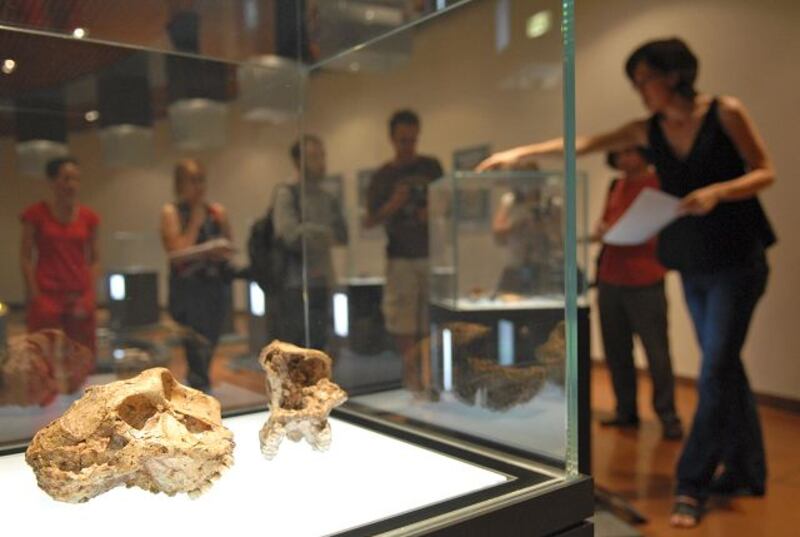MAROPENG, SOUTH AFRICA // The skull appears almost misshapen, with heavy ridges along the eyebrows, another on the top of the cranium, and wide cheekbones. But it is recognisably human-related, and staring into its deep eye-sockets is a window into the profoundest recesses of mankind's past. Estimated at up to 1.8 million years old, the relic of Paranthropus robustus has gone on display at Maropeng in the Cradle of Humankind, a region north of Johannesburg in South Africa that is home to the richest trove of hominid fossils anywhere on Earth. Most of the fossils and tools in the exhibition are normally kept under lock and key in museum vaults, but have been united for the first time for the show. Paranthropus was about 1.1 metres to 1.2m tall, with a brain size of about 530 cubic centimetres, less than half that of a modern human, and had a lifespan reaching only into its early twenties. The species went extinct about one million years ago, but its discovery in the 1930s was a vital step in the understanding of human evolution. Amid the rolling hills of the Cradle, Paranthropus coexisted with another early hominid species, Homo ergaster. The latter was the first to develop stone tools - although Paranthropus may have used bone and horn implements - and the first evidence of controlled hominid use of fire, burnt animal bones exposed to temperatures as high as 200°C, dates from the period and is also on display. But when the climate shifted, becoming more arid, and the area's plant life that provided Paranthropus' food changed, they were unable to cope. "Being a vegetarian will make you extinct," joked Christine Steininger, a paleoanthropologist. "Paranthropus used a very niche part of the environment whereas early Homo was very much more general," said Lindsay Marshall, curator of the Maropeng exhibition centre. "Early Homo could accommodate and survive across a much broader environment." As an evolutionary dead end, Paranthropus is more of a cousin to modern man than a direct ancestor, but its existence is proof that the pattern which finally led to the emergence of homo sapiens sapiens is far more complicated than a simple straight line. "What makes Paranthropus so special is they were coexisting with Homo ergaster but would ultimately die out," Ms Marshall said. "We are dealing with an evolutionary tree, branches that are sprouting off, species that eventually died out." Nonetheless it exhibits several significant human characteristics. Merely from the curved surface of one of its metatarsal bones, Bernard Zipfel, the curator of collections at the University of the Witwatersrand and also a paleoanthropologist, can deduce that it walked on two legs, albeit not as efficiently as modern humans. "Walking upright is one of the primary evolutionary occurrences towards us as humans today," he said. "Once we got up on to our hind legs we were able to free up our hands to do more with them and then that developed the brain. "Paranthropus is the bipedal ape, Homo ergaster is probably moving towards being on its way to becoming an intelligent ape." The exhibition centre at Maropeng - the name means "return to the place of origin" - is the centrepiece of southern Africa's claim to being the birthplace of modern humanity. East Africa is generally regarded as where the first hominid species evolved, thanks to the world-renowned discoveries of Richard Leakey and examples such as Lucy, a 3.2-million-year-old Australopithecus afarensis. But specialists in South Africa are keen to stress their own area's vital role, and the geographical rivalry is an extra element in the academic debate on the intricacies of human evolution - which is ever more intense, millions of years after the events it is considering. "If they are from East Africa they say East Africa is where it all happens, if you just look at the data it's southern Africa," Ms Steininger said. Mr Zipfel suggests that the human family first evolved in East Africa, but then developed to the north and south, the result of several different migrations over time. "We think the human lineage is unequivocally African," he said. "The oldest modern human came from here in southern Africa. Lucy is an ape. Early hominids were essentially bipedal apes, we can't talk of them as human. We only became human 120,000 to 150,000 years ago." The earliest homo sapiens sapiens remains, from 90,000 years ago, were found in South Africa, he said. Ms Marshall acknowledged the greater age of the East African fossils, but sought to be diplomatic. "I think both areas have an equal claim, but I have to say that," she said. "Our emphasis is on Africa as a home." sberger@thenational.ae
Fossil unravels secrets of human origins
Considered to be cousin to modern man, Paranthropus was dependent on plant life for food and perished when conditions grew arid.

Editor's picks
More from the national




